I was on a completely unrelated mission when I spotted an unfamiliar plant with tiny lavender blossoms growing in totally dry gravelly soil alongside a busy road. Close inspection revealed that its dull gray foliage had a powerful aroma, which reminded me of turpentine or paint thinner. A photo of it enabled Ranger Amy at Sycamore Grove Park to identify it as vinegar weed, a California native, Trichostema lanceolatum.

A member of the mint family (Lamiaceae), it has been called stink weed, vinegar weed, turpentine weed and camphor weed, and more appealingly as blue-curls, romero, yerba del aigre and wild rosemary. (My impression of the aroma of the foliage was more like that of turpentine than of vinegar.) But like the ugly duckling in the fable by Hans Christian Anderson, vinegar weed turns out to be an impressively useful and interesting member of the native plant family!
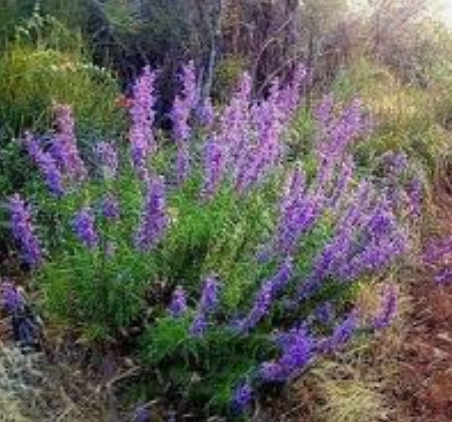
In contrast, vinegar weed (Trichostema lanceolatum) has a more comely relative with a similar name: woolly blue curls, Trichostema lanatum. The former stays close to the ground, about 1-3 feet tall, and has slender, dull gray-green leaves which help it reflect the summer sun, and smell like turpentine (my opinion). It blooms from August to October. Its leaves are dotted with glands that produce the strong odor.
The latter grows between 3-4 feet tall, and has slender leaves of a rich green color; it has deep blue blossoms from March to June. Bert Wilson likened the aroma of the foliage to “freshly cut cedar with a bouquet of lavender”, and reminds Annie of Alden Lane Nursery of lemon verbena. The blossoms of both species are covered with tiny, fine “woolly” hairs, which can be seen in the blossom photo below if you look closely. Both species have long arched stamens that make its pollen readily available to visiting bees.
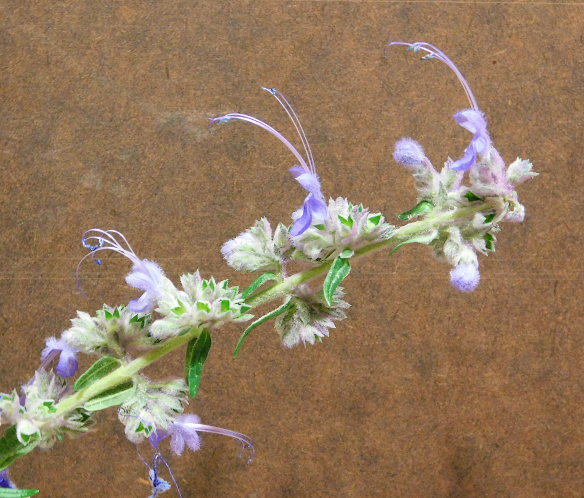
What Makes Vinegar Weed Special?
While vinegar weed doesn’t have the good looks of its relative, the indigenous peoples of California nevertheless valued it highly for reasons related to medicine, pest deterrence, and fishing success. The medicinal values of vinegar weed were valued by the Salinan, Ohlone, Miwok and many other tribes. A tea made from the strongly aromatic leaves and flowers was used to ease colds, stomachaches, headaches, sore throats, smallpox, fever and chills resulting from malaria, and bladder problems. Sitting over a steaming decoction of the leaves treated uterine trouble. The ground leaves were rubbed on the face and chest of persons with colds or any place on the skin that was experiencing pain. The leaves were chewed to ease a toothache.
The leaves and stems were crushed and placed in bedding to repel fleas. The mashed or powdered plants were thrown into pools of water to make fish sluggish and easy to catch in nets or sieves made of willow.
A Newsletter Extra: The Effect of Smoke and Ash on Plants
(The following is adapted from an essay by Dr. Lewis Feldman, Garden Director, University of the California Botanical Garden at Berkeley, October 1, 2020.)
Many native plant gardeners have reported unusual or unexpected things that have been going on with our native plants this Summer and Fall. The reduced sunlight from the smoke resulting from the multiple fires in central California this August and early September, as well as the lowering water table over the past few years, seems to have made some of the plants at the Granada Native Garden think that Fall had arrived early. Some of them started losing their leaves weeks prematurely, like the valley oak and desert olive in these photos below, taken the first week of September. (Photos can be enlarged by clicking on them.)
The effect of the smoke seems to be even more critical. Leaves have small openings on the surfaces of their leaves. These openings, called stomates (stomata) allow carbon dioxide (needed for photosynthesis) to enter the plant, and oxygen (a product of photosynthesis, along with glucose) to exit to the atmosphere.
But smoky air contains much more than carbon dioxide and oxygen. “More than 100 different compounds have been identified in smoke, including toxic levels of nitrous oxide, sulfur dioxide and ozone. Short-term exposure to smoke (as little as 20 minutes) has been reported to reduce photosynthesis by as much as 50%, as a result of both the destruction of chlorophyll and in impeding the movement of carbon dioxide (CO2) into the plant.
“A reduction is photosynthesis is usually accompanied by a lessening in plant growth, including a reduction in fruit production and in slowed ripening. Ash particles in the smoke are also detrimental to plant growth by clogging the stomates. When ash lodges in a pore, not only is the intake of CO2 retarded, but the pore can no longer function efficiently in preventing water loss from the plant, which, as a consequence increases the likelihood of the plant suffering from water stress.”
Quotable Quote
“The native plant movement is an important one, but we won’t be attracting many people if we are not able to meet their expectations. People are not going to choose to landscape with native plants unless their needs get met. Cultivars and selections are made in order to meet some of those needs. If those needs are not met with native plants, people are going to choose exotic species which do meet them.” – Pete Veilleux, East Bay Wilds, Oakland, CA
Guided Tours of the Granada Native Garden Are Available Are you interested in seeing some of the plants that are described in this Newsletter or in past issues? One or more staff of the GNG are routinely on duty at the Garden on Mondays and Thursdays, roughly between 10:00 AM and 12:00 noon. But it isn’t very hard to arrange a guided visit at other times. If you are interested in scheduling a visit, just email Jim at JIMatGNG@gmail.com . Or if you have any questions or inquiries, please email Jim at the same address! Directions to the Garden and information about volunteering there can be found by clicking one of the buttons at the top of the first page of this Newsletter.

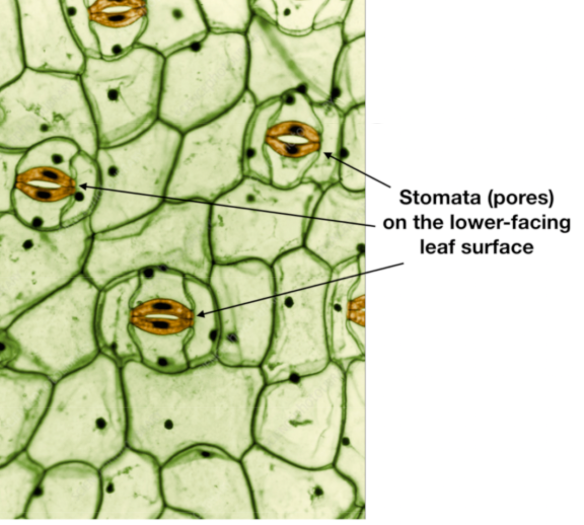
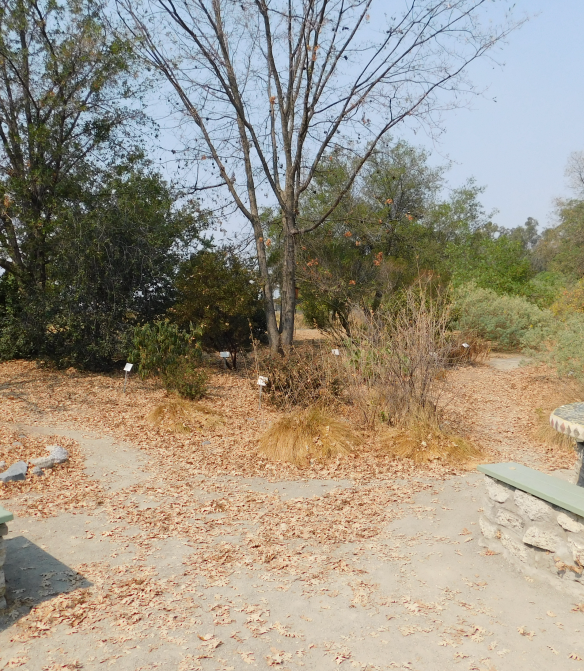
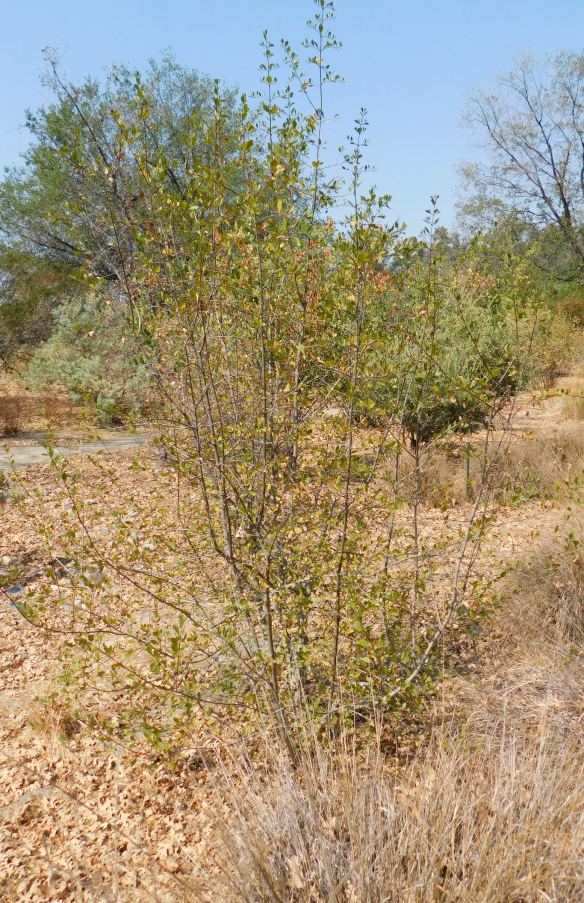
Another well written newsletter – thanks Jim!!! The Valley Oak in my yard hasn’t dropped hardly any of it’s leaves, interesting how differently it’s acting from the Valley Oak in GNG. I do have a few CA natives around my Oak on drip irrigation, now I’m wondering if their residual irrigation is affecting my Oak…
Hi, Cindy,
Not all the valley oaks at GNG are reacting the same. There are two oaks in the photo, side by side, both valley oaks. The one on the right is leaf-less, the one on the right mostly normal. Of course, neither are irrigated. Who knows? Probably something different in their DNAs because of cross-hybridization?
BTW, the hazelnut you showed interest in last year is doing well, and has actually put on some new growth in the past few weeks.
~ Jim
Regarding smoke… I thought the same that the leaves we’re getting clogged so I tried to ‘wash’ my plants with a hose. It may have helped, but I also think it may have spread some fungi too. Do you recommend watering them on top or as a native garden, do you just let them be? Is the GNG irrigated?
In most plants, the stomates are mostly on the underside of the leaves. Nonetheless, hosing off native plants from time to time is often recommended. However, we have no such capability at the GNG, as there are no irrigation lines and I bring water from home in order to irrigate new plantings and some plants that require a little summer water.
~ Jim
Hi, Jim,
Thanks for keeping us on the GNG email list. The last newsletter is very interesting. Are you keeping the vinegar weed in the garden?
Smoke’s impacts on plants is both interesting and disturbing. My goodness, something else to stress out the plants.
I’m sorry to not visit before moving out of Livermore. Every time I went by GNG I looked for you but didn’t see you. Our house sold in mid-July. The buyers asked for an early close. We waited until their (large) loan was approved by a bank, then found a place to rent and moved, all within ten days. It was a whirlwind.
Sam and I are now renting a house in Napa, within walking distance of downtown. We are enjoying time to explore the area, and getting lots of biking and hiking in. We are watching the housing market and plan to buy a place when our lease is up. It is frustrating to not have a garden of our own.
Our best to you and the GNG team! Miss you!
Regina
On Tue, Oct 13, 2020 at 2:16 PM The Granada Native Garden Newsletter wrote:
> jimlibjen posted: ” I was on a completely unrelated mission when I spotted > an unfamiliar plant with tiny lavender blossoms growing in totally dry > gravelly soil alongside a busy road. Close inspection revealed that its > dull gray foliage had a powerful aroma, which reminded ” >
Cyn,
Go to “Granada Native Garden Newsletter” on the Internet. Click the Directions button at the top of the page.
~ Jim